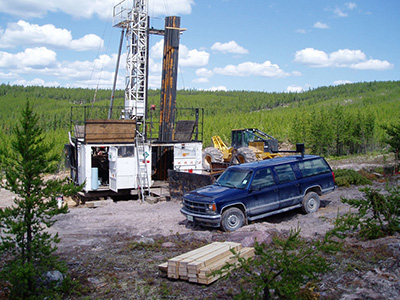Case Study
Making Exploration More Efficient

Cameco’s exploration program, which once spanned six continents, now focuses primarily on the company’s core areas of Saskatchewan and Australia.
Scaling back global exploration to concentrate on these targets is part of a company-wide strategy to improve profitability and long-term viability.
“Over the last two years, we’ve been able to put more resources and energy into our highest priority targets while reducing our overall budget,” said Scott McHardy, vice-president, exploration. “We’ve got some of the most prospective land in the world, so we’re trying to do definitive exploration in those areas.”
The epicentre of that exploration is northern Saskatchewan’s Athabasca Basin – where Cameco’s operations already include the world’s two largest high-grade uranium mines, McArthur River and Cigar Lake – as well as Australia where assets include the Kintyre and Yeelirrie projects. Northern Saskatchewan and parts of Australia have a common geological thread. Both host unconformity deposits, meaning the orebodies are sandwiched between different types of rock. Cameco has extensive experience mining this type of deposit.
“We changed our exploration focus from three or four geological models to one, and that brought us back to Canada and Australia,” said McHardy.
Dave Thomas, Cameco’s director of exploration geoscience, describes the unconformity model as a “time break” in the formation between rocks. Following a long period of erosion, a younger package of rocks is laid down on top of the basement rock, creating favourable conditions for the formation of a high-grade uranium deposit.
“The higher the grade, the less rock you have to move to get that uranium and you, therefore, lower your costs,” said Thomas.
As for exploration costs, Cameco plans to spend approximately 35% to 40% less on exploration in 2014. The company suspended exploration in Mongolia and other non-core areas, and divested its interests in Argentina and Peru in 2013.
“By sharpening our focus,” said McHardy, “we can put a magnifying glass on our core areas.”
Geoscience – which includes geophysics, geochemistry and geology – has since revealed common characteristics in those “curiosities.” Exploration teams use those clues to target their searches.
“We use those three sciences to help us better select areas to explore,” said Thomas. “Geophysics involves measuring the physical properties of the rocks in a particular region or district. We also look at the chemistry of those rocks if they seem to be anomalous in certain elements. Then we look at the relationship between those rocks to determine whether it’s the right kind of relationship to find this kind of uranium deposit or that kind of uranium deposit.”
In addition to applying geoscience, Cameco’s exploration team has implemented a data-management strategy. Exploration data is now accessible through standardized software platforms – an improvement that should translate to greater efficiency in the field.
“We’re not drilling random holes,” concluded McHardy. “Everything is based on knowledge.”
